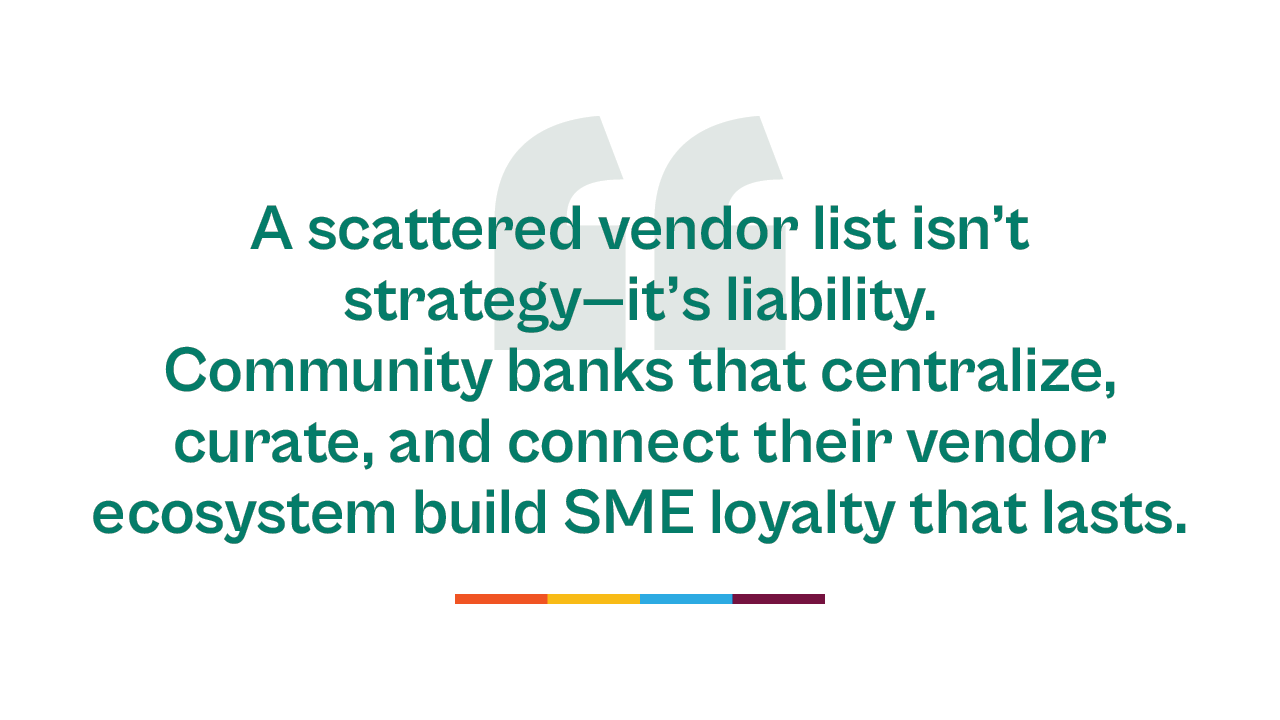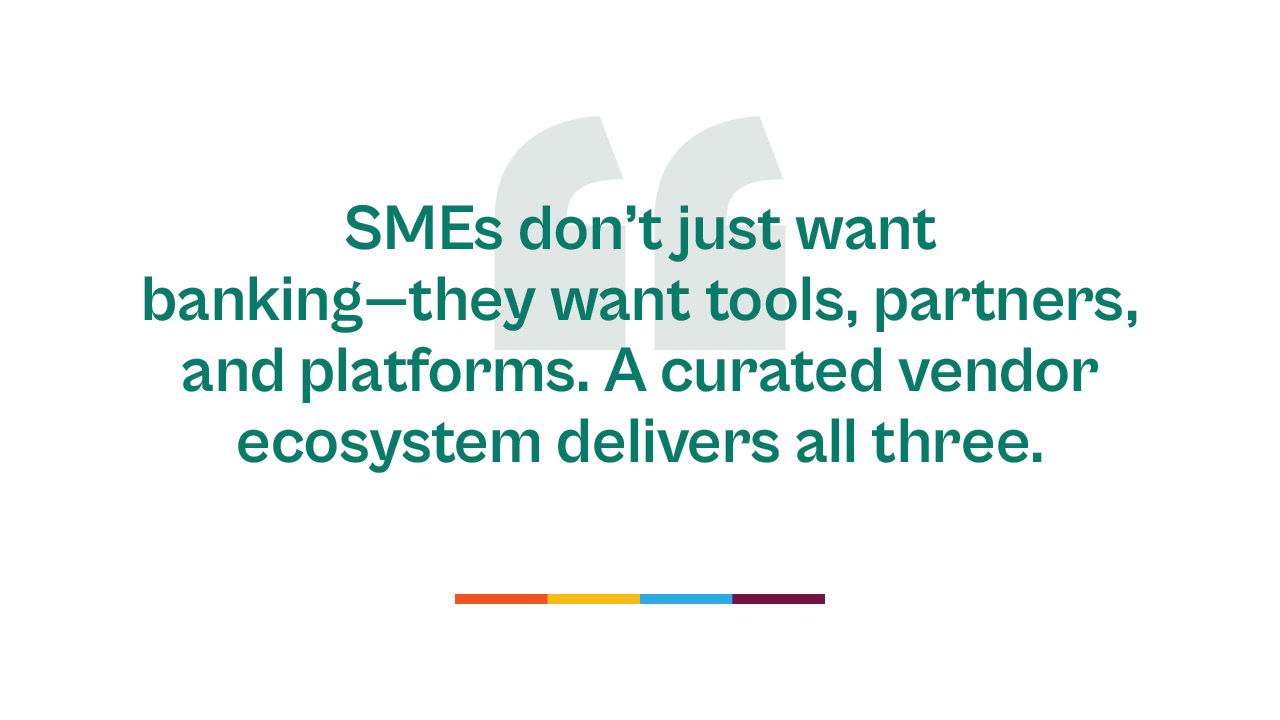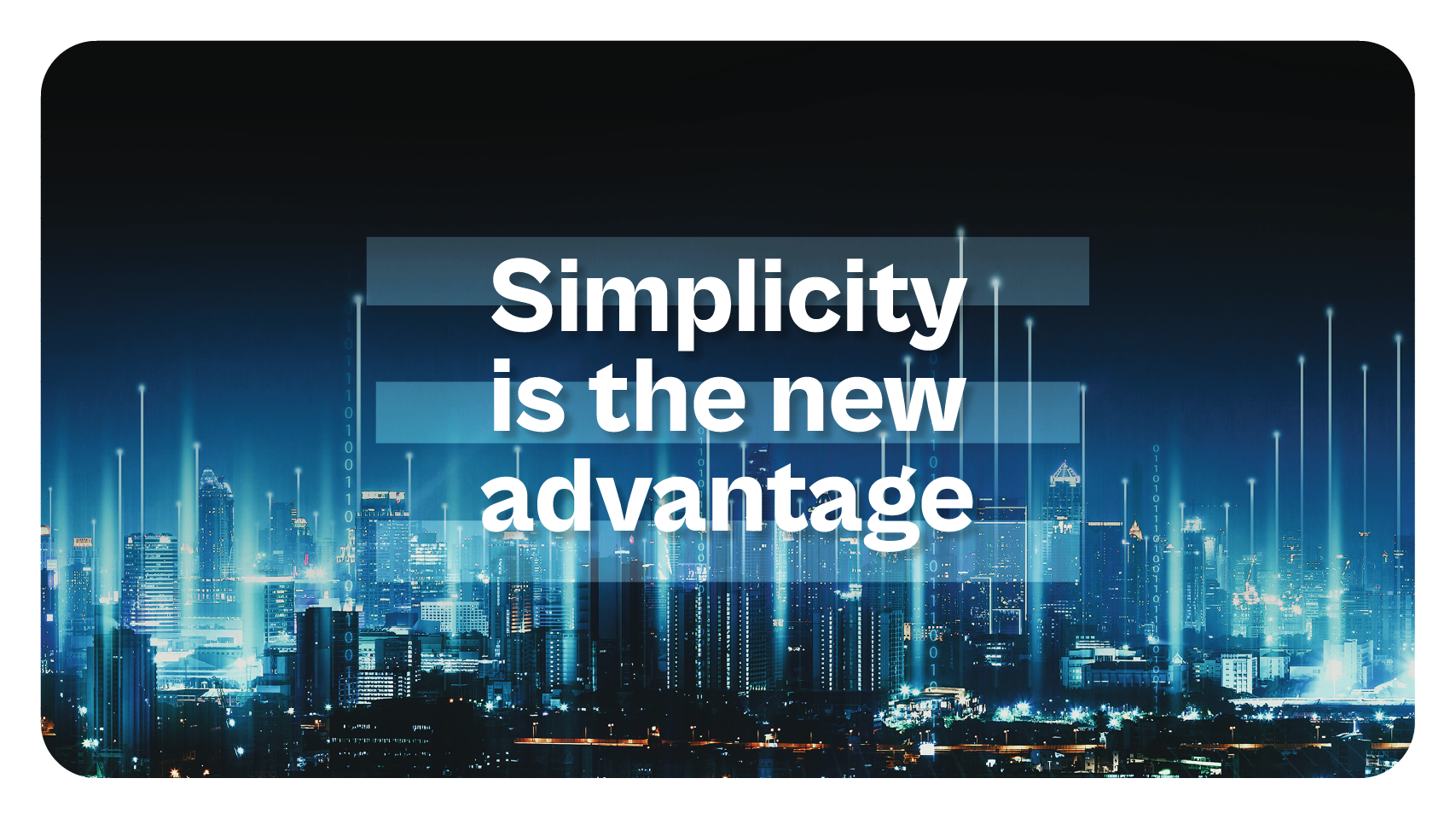
The Hidden Costs of Not Having a Vendor Management Strategy for Your SME-Focused Bank

As community and SME-focused banks look to compete in an increasingly digital, value-driven market, more institutions are turning to third-party vendors to provide added benefits to their small business clients.
These vendors—ranging from accounting software providers to legal service platforms—can serve as powerful extensions of your bank's value proposition.
But here’s the catch: having vendors is not the same as having a streamlined vendor strategy.
Without structure, oversight, or alignment, vendor relationships can drain time, create risk, and quietly erode your bank’s reputation. In this article, we'll evaluate the hidden costs of neglecting vendor management and outline how a proactive, SME-focused approach can unlock resilience, retention, and revenue.
The Hidden Costs of Poor Vendor Management
While third-party vendors are essential for expanding service offerings and creating value for SME clients, poor management of those partnerships comes at a cost—often one that's hard to quantify until it’s too late.
Below you will find five of the most common and consequential downsides of lacking a formal vendor monitoring and management strategy, from financial inefficiencies to reputational risk, and why community banks can’t afford to overlook them.
1. Financial Losses
Vendor sprawl often starts quietly but quickly balloons into a costly burden. Without clear ownership, centralized oversight, or performance data, financial inefficiencies build up across departments. In the case of financial institutions, we see this in the form of:
- Redundant tools: Banks often pay multiple vendors for similar services because teams onboard vendors independently.
- Contract mismanagement: Renewal dates are missed, discounts are left on the table, and overpayments go unnoticed due to a lack of contract visibility.
- Untracked ROI: Vendors continue receiving payment even when SME adoption is low or benefits go unused.
For example, suppose a regional bank is overpaying for three HR software platforms across various departments, none of which have had active SME engagement over the past quarter.
Without a system to compare performance or negotiate better terms, this financial leakage not only strains the budget but also hinders the bank's ability to invest in tools and partnerships that provide measurable value. This scenario occurs more frequently than we realize, highlighting the critical need for effective vendor management.
2. Compliance and Regulatory Risk
In today’s tightly regulated financial environment, banks are expected to maintain rigorous oversight not only of their internal operations, but of all third-party relationships. In addition, data security is becoming increasingly critical in today's information-first era.
Compliance breaches stemming from vendor mismanagement can lead to significant legal, financial, and reputational consequences.
When vendor risk isn’t proactively monitored, banks are vulnerable to:
- Non-compliance with frameworks like GDPR, FFIEC, OCC, and others, especially when handling sensitive customer data.
- Cybersecurity exposures caused by poorly secured vendor systems, which can result in breaches or service outages.
- Audit failures and enforcement actions, which can include fines, public disclosures, and mandated operational changes.
Real-World Case: TSB Bank’s 2018 IT migration debacle is a textbook example. Its vendor failed to deliver a seamless transition, causing a massive service outage that affected nearly 2 million customers. The incident triggered an investigation by the Financial Conduct Authority (FCA), led to leadership shakeups, and permanently impacted customer trust.
What’s often overlooked is that community banks are just as exposed—if not more—due to leaner compliance teams and fragmented vendor oversight. A proactive vendor risk management strategy helps detect early warning signs, ensures vendors adhere to industry standards, and protects the bank from becoming the next headline.
3. Reputational Damage
In the banking sector—especially among community and other SMB focused institutions—reputation is everything. Trust is the currency that keeps clients engaged and loyal.
When a vendor fails, clients don’t distinguish between your platform and the third party. They blame the bank.
The reputational fallout from poor vendor experiences can be wide-reaching:
- Cyber breaches through third-party providers are often traced back to a bank’s lack of due diligence.
- Unreliable or irrelevant services bundled into your platform create frustration and undermine credibility.
- Public backlash—especially in today’s social media age—can quickly erode trust and trigger negative press cycles.
Even minor service failures, like a non-responsive customer support experience from a vendor, can reflect poorly on your institution. For SME clients already juggling growth, operations, and financial management, one frustrating vendor interaction could be enough to consider switching banks.
In short, every vendor you recommend becomes an extension of your brand. If they underdeliver, your reputation does too. Implementing a robust vendor management strategy not only protects your clients but also safeguards your bank's public image and long-term growth potential in the small business banking sector.
4. Operational Inefficiencies
Behind every poorly managed vendor is often an overworked team trying to compensate with spreadsheets, emails, and meetings.
Community banks without a centralized vendor strategy often find themselves stuck in reactive cycles that strain staff capacity and reduce institutional agility.
Have you seen any of these inefficiencies lately?
- No unified view of vendor activity: Without a central dashboard, staff must chase down contract dates, service-level agreements, and renewal deadlines across departments.
- Lack of performance tracking: Banks can’t measure vendor ROI or impact on SME clients if usage data and satisfaction metrics aren't collected.
- Manual onboarding processes: Every new vendor adds overhead—from compliance checks to training to integration—which is magnified without automation.
These inefficiencies compound over time. Employees spend hours managing vendor relationships that should have been streamlined or eliminated. Worse, there's often no system for prioritizing vendors based on performance, value, or client relevance—leading to overlapping roles, duplicated work, and stalled innovation.
What's missing is a centralized and streamlined vendor management solution that can help a small SME-focused bank relocate its internal resources to more strategic tasks while improving speed, scalability, and coordination across teams.
If that's something your bank could use help with, Proven is the right solution for your institution. Learn more here.
5. SME Client Attrition
Today’s SMEs are digitally savvy, growth-oriented, and expect their financial partners to be more than transactional service providers. They are looking for strategic allies who understand their challenges and can support them with relevant tools, services, and connections.
Without an intentional vendor strategy, banks risk falling short of these expectations.
>> If your bank doesn’t offer a cohesive, value-driven ecosystem, SMEs will look elsewhere—likely to a fintech or digital-first competitor that does.
>> Generic vendor lists and outdated landing pages erode trust and fail to deliver the utility SMEs want from their financial provider.
>> Lack of visibility and personalization in vendor offerings makes the relationship feel one-size-fits-all, which doesn't resonate with today's highly segmented SME market.
Moreover, SME clients are more willing than ever to switch providers when their needs aren't met. A Forrester study found that 41% of SMEs plan to switch their primary banking provider within the next 12 months. The top reasons? Lack of digital value, tools, and support tailored to their business growth.
Banks that take the time to build curated vendor ecosystems—integrated with digital banking tools and supported by analytics—position themselves as indispensable growth partners.
The cost of not doing so isn’t just operational; it’s strategic, with real implications for client retention and long-term revenue.

Why Vendor Strategy Should Be a Growth Lever
Many banks view vendor management primarily as a regulatory or cost-control function—but for SME-focused institutions, it should be seen as a powerful engine for growth.
Done right, vendor strategy doesn’t just mitigate risk—it enhances competitiveness, deepens client relationships, and positions your bank as an indispensable business partner.
Here are some ways you can proactively unlock advantages that directly support SME retention and revenue expansion.
Improved Compliance & Risk Mitigation
A structured vendor management approach helps ensure your bank avoids regulatory pitfalls and maintains strong governance across all partnerships. Here's what to do:
- Assess vendors using internationally recognized frameworks like ISO 27001 or NIST to evaluate cybersecurity and operational risk.
- Track vendor performance against compliance standards and audit obligations to stay prepared for external reviews.
- Set up internal workflows for pre-contract due diligence and periodic reviews.
By embedding compliance into vendor selection and monitoring, banks can avoid costly enforcement actions and confidently scale vendor relationships without compromising integrity.
Stronger Vendor Relationships
Treating vendors like strategic partners rather than just service providers leads to stronger, more productive outcomes. Consider the following:
- Shared dashboards and performance data ensure accountability and alignment on goals.
- Clear expectations create more reliable deliverables and service quality.
- Vendors are more likely to co-invest in exclusive deals, joint campaigns, or training when they’re integrated into a long-term roadmap.
This strategic collaboration turns vendors into value creators—boosting SME satisfaction and enabling service innovation your competitors can’t easily replicate.
Cost Savings
One of the most tangible outcomes of a smart vendor strategy is reduced operational waste:
- A centralized vendor platform helps eliminate underused or duplicate services.
- Contract consolidation creates leverage for bulk pricing or bundled savings.
- Standardized onboarding and usage tracking reduce hidden costs like training, support, and internal inefficiencies.
These savings don’t just protect margins—they free up budget for higher-impact tools and programs that support SME growth.
Enhanced Service Delivery for SMEs
Curated, high-performing vendors extend your bank’s value proposition in ways that matter to small businesses. For example:
- Relevant tools (e.g., payroll software, e-invoicing, legal templates) are easier to access through a single, trusted platform.
- Pre-negotiated discounts and seamless integration with banking products create measurable time and cost savings.
- A well-designed vendor ecosystem positions your bank as a one-stop shop—not just for financing, but for solving everyday operational problems.

What a Modern Vendor Management Strategy Looks Like
Now that we’ve covered the risks of poor vendor oversight and the potential business value of doing it right, the question becomes: What does a modern, SME-focused vendor strategy actually look like in practice?
For community banks that want to compete with fintechs and retain SME clients, this section breaks down the essential building blocks of an effective vendor management framework with a focus on practical, scalable, and client-centric implementation.
1. Vendor Risk Assessment
Vendor relationships must begin with a clear and thorough evaluation process. This ensures you're selecting partners that not only meet regulatory standards, but also align with your brand and SME client needs.
Key areas to assess include:
- Financial viability: Can the vendor scale with you and support long-term service?
- Security posture: Are there appropriate controls for cybersecurity, data protection, and incident response?
- Regulatory compliance: Do they adhere to standards like ISO 27001, SOC 2, or FFIEC guidelines?
- SME relevance: Is the solution useful, accessible, and proven with small businesses?
Tip: Use standardized checklists or vendor scorecards tailored to banking to speed up and scale risk evaluations across departments.
2. Ongoing Monitoring & Performance Tracking
Risk assessments are just the beginning. Ongoing vendor evaluation is what keeps the relationship healthy and productive.
Best practices include:
- Quarterly or bi-annual reviews of vendor performance against key SLAs (service-level agreements)
- Client-side feedback loops, including SME surveys and usage monitoring
- Internal metrics, such as contract utilization, cost-to-value ratio, and renewal viability
Tip: Incorporate performance tracking into your vendor platform so KPIs are transparent and always up to date.
3. Centralized Vendor Management Platform
Managing vendor relationships in spreadsheets and emails is a recipe for risk and inefficiency. A centralized vendor management system (VMS) automates workflows and keeps all stakeholders aligned.
Core functions should include:
- Contract lifecycle management
- Document storage and renewal tracking
- Role-based access for compliance and procurement teams
- Integrated feedback and performance dashboards
Bonus: With the right platform, you can even allow SME clients to browse vendor options, redeem offers, or provide reviews—creating a living ecosystem of business support.
4. Build an SME-Focused Vendor Ecosystem
Vendor management should go beyond internal efficiency—it should extend value directly to SME clients. A curated digital marketplace builds loyalty by solving real business problems.
Here’s what an SME-focused vendor ecosystem should offer:
- A trusted shortlist of pre-approved vendors relevant to core SME needs (e.g., accounting, HR, logistics)
- Exclusive value, such as negotiated pricing or onboarding support
- Tight integration with banking tools, like business checking, payments, or lending dashboards
Tip: Personalize the vendor experience using SME segmentation data. A tech startup shouldn’t see the same offers as a local retailer.
Want to see how much your SME clients could save with a curated ecosystem? Try our SME Savings Calculator
Conclusion
Vendor management is no longer just a back-office function—it’s a strategic lever for growth, efficiency, and SME loyalty. Banks that take a reactive or fragmented approach will continue to face hidden costs, from financial waste and compliance exposure to client attrition.
But those that embrace a modern, proactive vendor strategy can unlock significant advantages. From improving internal operations to delivering curated value through digital ecosystems, community banks have a clear opportunity to differentiate themselves by transforming how they manage and activate their vendor relationships.
The path forward is clear: centralize, curate, and connect.
Make your vendors part of the value you offer—not a liability you hide.
Ready to modernize your bank’s vendor ecosystem and strengthen SME loyalty? Book a demo of Proven’s white-label vendor management platform













